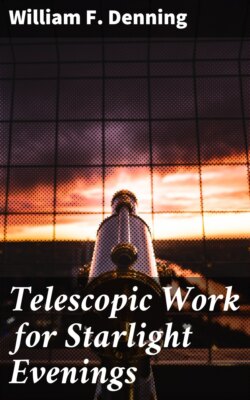| Fig. | | Page |
| 1. | The Galilean Telescope | 7 |
| 2. | Royal Observatory, Greenwich, in Flamsteed’s time | 8 |
| 3. | Sir Isaac Newton | 10 |
| 4. | Gregorian Telescope | 10 |
| 5. | Cassegrainian Telescope | 11 |
| 6. | Newtonian Telescope | 11 |
| 7. | Common Refracting-Telescope | 12 |
| 8. | Le Mairean or Herschelian Telescope | 13 |
| 9. | 10-inch Reflecting-Telescope on a German Equatoreal, by Calver | 17 |
| 10. | Lord Rosse’s 6-foot Reflecting-Telescope | 22 |
| 11. | Refracting-Telescope, by Browning | 32 |
| 12. | “The Popular Reflector,” by Calver | 40 |
| 13. | 3-inch Refracting-Telescope, by Newton & Co. | 41 |
| 14. | Huygens’s Negative Eyepiece | 46 |
| 15. | Ramsden’s Positive Eyepiece | 47 |
| 16. | Berthon’s Dynamometer | 50 |
| 17. | Cooke and Sons’ Educational Telescope | 52 |
| 18. | Refracting-Telescope on a German Equatoreal | 67 |
| 19. | The Author’s Telescope: a 10-inch With-Browning Reflector | 77 |
| 20. | Sun-spot of June 19. 1889 | 95 |
| 21. | Solar Eclipses visible in England, 1891 to 1922 | 98 |
| 22. | Total Solar Eclipse of August 19, 1887 | 98 |
| 23. | Belts of Sun-spots, visible Oct. 29, 1868 | 104 |
| 24. | Shadows cast by Faculæ | 109 |
| 25. | Light-spots and streaks on Plato, 1879–82. (A. Stanley Williams.) | 126 |
| 26. | Petavius and Wrottesley at Sunset. (T. Gwyn Elger.) | 129 |
| 27. | Birt, Birt A, and the Straight Wall. (T. Gwyn Elger.) | 130 |
| 28. | Aristarchus and Herodotus at Sunrise. (T. Gwyn Elger.) | 132 |
| 29. | Mercury as a Morning Star | 143 |
| 30. | Venus as an Evening Star | 150 |
| 31. | Mars, 1886, April 13, 9h 50m | 157 |
| 32. | Orbits of the Satellites of Mars | 159 |
| 33. | Jupiter, as drawn by Dawes and others | 178 |
| 34. | Jupiter, 1886, April 9, 10h 12m | 180 |
| 35. | Occultation of Jupiter, Aug. 7, 1889 | 186 |
| 36. | Jupiter and Satellites seen in a small glass | 187 |
| 37. | Shadows of Jupiter’s Satellites II. and III. | 192 |
| 38. | Saturn as observed by Cassini in August 1676 | 198 |
| 39. | Saturn, 1885, Dec. 23, 7h 54m | 201 |
| 40. | Saturn as observed by F. Terby, February 1887 | 203 |
| 41. | Apparent orbits of the Five Inner Satellites of Saturn | 212 |
| 42. | Transit of the Shadow of Titan | 213 |
| 43. | Uranus and his belts | 218 |
| 44. | Apparent orbits of the Satellites of Uranus | 221 |
| 45. | Apparent orbit of the Satellite of Neptune | 224 |
| 46. | Mars, Saturn, and Regulus in same field, Sept. 20, 1889 | 226 |
| 47. | Comet 1862 III. (Aug. 19, 1862) | 237 |
| 48. | Sawerthal’s Comet, 1888 I. (March 25, Brooks) | 237 |
| 49. | Brooks’s Double Comet, Sept. 17, 1889 | 239 |
| 50. | Pons’s Comet (1812). Telescopic view, 1884, Jan. 6 | 242 |
| 51. | Ditto. Ditto, 1884, Jan. 21 | 242 |
| 52. | Radiation of Meteors. (Shower of early Perseids, 1878) | 263 |
| 53. | Double Meteor. Curved Meteor. Fireball | 265 |
| 54. | Meteorite found in Chili in 1866 | 265 |
| 55. | Meteorite which fell at Orgueil in 1864 | 265 |
| 56. | Fireball of Nov. 23, 1877, 8h 24m (J. Plant.) | 269 |
| 57. | Flight of Telescopic Meteors seen by W. R. Brooks | 272 |
| 58. | Meteor of Dec. 28, 1888, 6h 17m | 277 |
| 59. | Large Meteor and streak seen at Jask | 278 |
| 60. | The Constellation Orion | 289 |
| 61. | Diagram illustrating the Measurement of Angles of Position | 291 |
| 62. | Double Stars | 301 |
| 63. | Trapezium in Orion as seen with the 36-inch refractor | 319 |
| 64. | Nebulæ and a Star-cluster | 336 |
| 65. | Nebula within a semicircle of stars | 342 |
